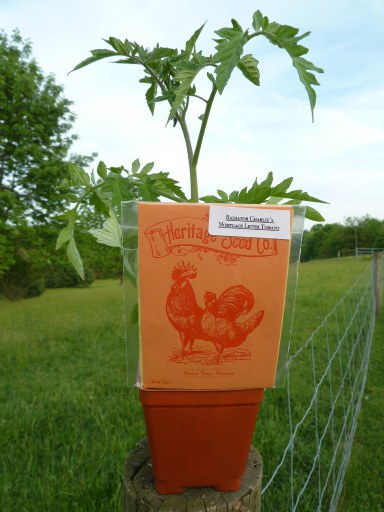WAgN members toured Blackberry Meadows and heard owner Jen Montgomery discuss their heritage seed saving initiative.
This isn't an Ark that collects species two-by-two. But the Heritage Seed Collective organized by farmers, Jen Montgomery and Greg Boulos of Blackberry Meadows Farm in Western Pennsylvania is all about saving species. They're growing thirty-two varieties of vegetables culturally and historically linked to the region and listed in the U.S. Ark of Taste published by Slow Foods. The compendium contains more than 200 rare and endangered regional foods. The plants will be sold at markets in the Pittsburgh area and costumers will be provided empty seed packets and instructions on how to save the seeds and contribute to the Heritage Seed Collective.
A PA-WAgN sponsored field day in April, 2013 provided local farmers and gardeners the opportunity to learn first-hand the techniques Jen and Greg use to grow and save seed. Here we provide a brief recapitulation of the information presented on seed growing and saving on Blackberry Meadows Farm. For more information on growing and saving seed, visit the Organic Seed Alliance website. Information for this report is taking from OSA's Seed Saving Guide. http://www.seedalliance.org/Publications/#SeedSavingGuide
The story of two's
OP vs. Hybrid
If you want a plant to resemble its parent, then the distinction between Open Pollinated (OP) and Hybrid varieties is the place to start. OP varieties are created from the combination of parent plants that are genetically similar and share specific traits. A seed saved from an OP plant will very much resemble the parent. Hybrids, on the other hand, are crosses from genetically distinct parents. If you want a plant to display traits of the parent, you don't want to save seeds from hybrid varieties.
Self-Pollination vs. Outbreeding
Whether in a greenhouse or the field, fertilization is an important part of the process of producing viable seeds. For plants that self-pollinate, a plant that mates with itself, some form of external movement is needed to transfer pollen. Wind and insects can increase pollination and promote a robust seed set. The same is true for outbreeding plants, but to an even greater degree. Outbreeding plants reproduce when the sperm of one plant fertilizes the ovule of another plant. For good pollination, these plants need frequent insect visitors and adequate airflow, a large population of plants flowering at the same time and environmental conditions that keep pollen viable.
Roguing
After planting according to appropriate isolation distances and population size, a farmer or gardener should rogue the crop by eliminating inferior or dissimilar plants from the population. By pulling out plants that you don't want to reproduce, undesirable traits will be removed from subsequent generations that would ultimately diminish the quality of the variety.
Dry seeds vs. Wet seeds
Wet seeds are found in the damp part of the fruit's flesh; plants with dry seeds have pods or husks where the seeds dry while still on the plant. For dry seeded crops, the color, the dryness and ease of detachment are all indicators that seeds have matured. Seeds of wet crops mature better when left on the vine for longer periods than would be expected if the vegetable was to be consumed. The process of "decanting" is one way in which wet seeds can be harvested. Threshing is performed to open the dry seed pods and the act of winnowing removes the plant material from the seed. See Suzanne Ashworth's book "Seed to Seed" for more details.
Moisture and Protection
Consideration for what material is best suited to store your seed must take into account how dry the container keeps the seed and how well it will protect against insects and other pests. Common materials include: paper or cloth; plastic bags; plastic tubs and bins; glass jars.
The limitations of thinking in two's
As with all activities involved in growing plants for foods, diversity is critical. Seeds require special consideration for not only the conditions of soil, water and sun, but also germination and breeding characteristics that make growing plants for seeds a distinct task from growing plants for food.
Pennsylvania Women's Agricultural Network
Address
302 Armsby BuildingUniversity Park, PA 16802
- Email pawagn@psu.edu
Pennsylvania Women's Agricultural Network
Address
302 Armsby BuildingUniversity Park, PA 16802
- Email pawagn@psu.edu


